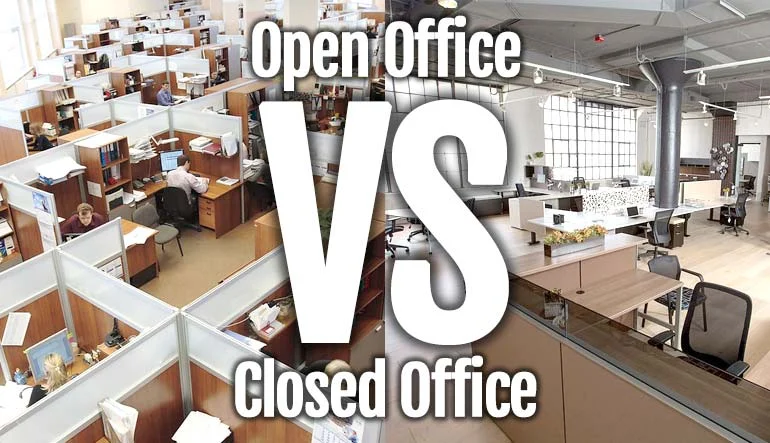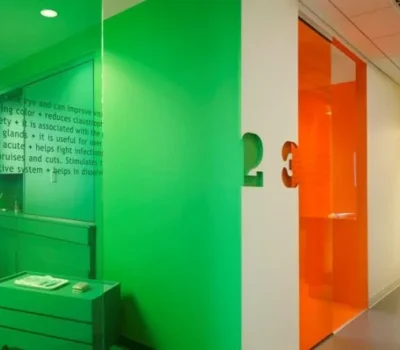When setting up an office, you will need to consider various factors.
Depending on the space available, you will need to fit the office furniture while making sure that each employee based in that office has sufficient working space.
You do not want to end up with frustrated workers bumping into one another as this reduces efficiency. Therefore the design of an office needs to be given careful consideration so as to ensure the best use of the office space and maximise employee motivation and efficiency.
There are two different kinds of office layouts that are generally applied: the Open and the Closed office layout.
What are the main differences between them, and which option is the most suitable for you? Let us discuss them both in more detail to help you make a well-informed decision.

The Open Office Layout
As the name itself implies, an open office is one which is essentially an open-plan environment.
So there aren’t going to be any cubicles or partitions that segregate workers from one another. All the employees will be able to see each other at their respective desks.
An Open Office layout naturally improves collaboration, as employees are able to see each other and well as converse together without having to leave their respective office or cubicle.
This may greatly improve teamwork and motivation.
Considering that a typical day in an office spreads over 8 hours in most cases, it is normal to feel bored if you are cooped up on your own in your office or cubicle.
Besides, whenever you need to go to speak to another employee you tend to waste time moving from your cubicle to his or hers. An Open Office layout helps to avoid this.
However, there are those who believe that with an open layout there could well be considerable time lost in useless conversations.
While better communication is encouraged, it is important to have some level of supervision so as to ensure that workers are not wasting too much time talking about mundane stuff that have absolutely nothing to do with the work at hand.
Another drawback of an open office layout is that if there are employees who have difficult personalities, or who do not like to collaborate with fellow workers, there are bound to be conflicts.
These could end up leading to demotivated staff and reduced productivity.
Also, there is the issue of noise. With several employees in an open area, there is bound to be more noise, which could also reduce productivity due to employees losing their concentration and focus.
However, all in all an open office layout has numerous advantages, and is favoured by companies that depend on employee participation and teamwork.
- Such a layout promotes collaboration, motivation and improved communication.
- It is a cost friendly option as you tend to save on office furniture and partitioning, as well as have more workers per square foot.
- Employees tend to feel more at home, less bored, and more energetic.

The Closed Office Layout
With a closed office layout each employee will have his or her individual working area.
This segregation is generally made by means of partitions or panels. As an employee has a separate cubicle where to work from, many feel that concentration levels are maximised, and so efficiency is boosted.
While this is true to a certain extent, it is important to note that for some employees being restricted to a cubicle for several hours a day may feel rather oppressive.
Those who have a lively personality and prefer social interaction are bound to feel unhappy with a closed office layout.
Such people work better when they are allowed to interact and collaborate with colleagues.
On the other hand, a closed office layout is ideal for those who like to work on their own in peace and quiet.
Naturally, an obvious advantage of this kind of layout is that there is going to be less noise than in an open office.
A closed office layout can be rather costly to set up, and as a result start-up firms or premises where space is limited are not in favour of it.
Additionally, with a closed office, there are going to be difficulties when it comes to supervising what each worker is up to.
In the seclusion of their cubicle, some employees may spend time doing stuff that is unrelated to their work tasks, such as calling home, browsing on the internet, or simply idling.
However, a closed office layout does have a number of benefits, including:
- Minimal distractions which can improve productivity and efficiency.
- Some workers perform better when allowed to have their personal work space and some privacy.
- Better in terms of physical health safety.
- A clear hierarchy is established.
Conclusion
While both office layouts have their respective pros and cons, the success behind your choice ultimately depends on the type of employees you will have.
Their personalities and working preferences will reflect on the success of the office layout that is used.
So whenever possible, you should choose an office layout that can accommodate your employees’ personality traits for maximum efficiency.




